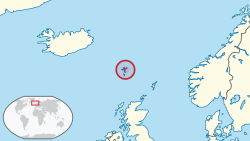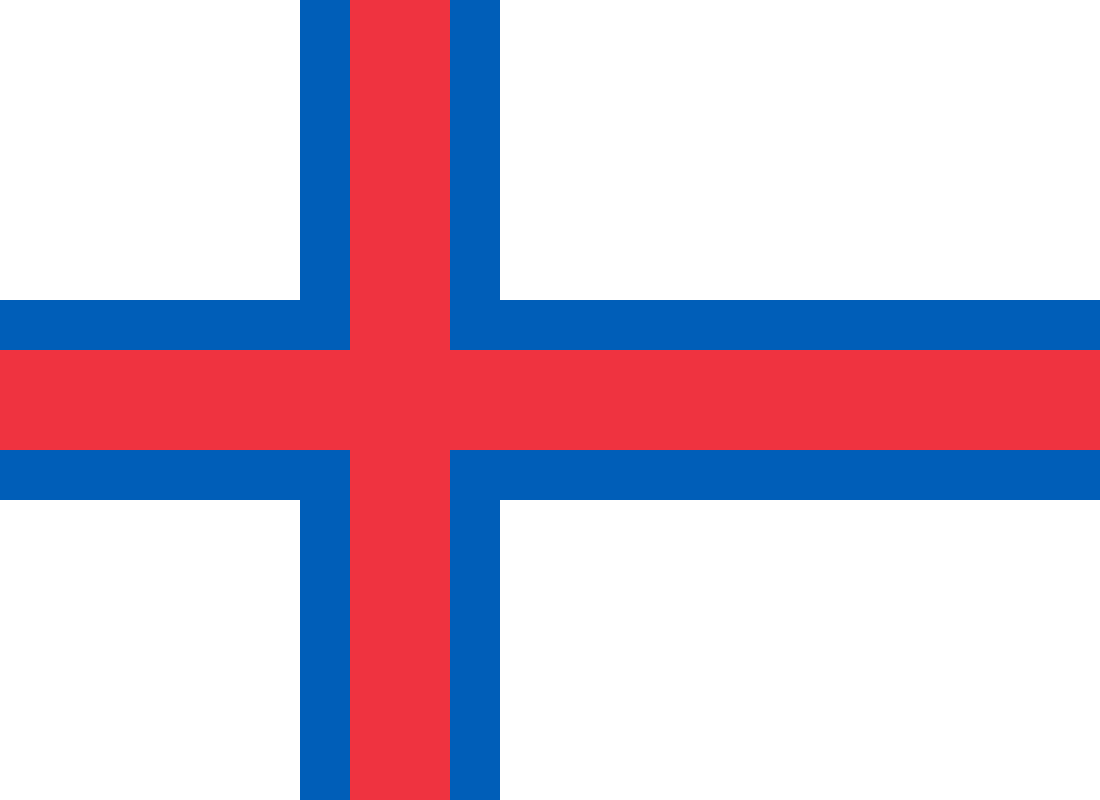Faroe Islands
North Atlantic archipelago organized as an autonomous constituent country of the Kingdom of Denmark From Wikipedia, the free encyclopedia
The Faroe Islands or Føroyar (that meaning "Sheep Islands") are a group of eighteen islands in the north Atlantic Ocean between Scotland, Norway, and Iceland.
Faroe Islands Lua error in package.lua at line 80: module 'Module:Lang/configuration' not found. Lua error in package.lua at line 80: module 'Module:Lang/configuration' not found. Lua error in package.lua at line 80: module 'Module:Lang/configuration' not found. Lua error in package.lua at line 80: module 'Module:Lang/configuration' not found. | |
|---|---|
| Motto: Vivre Libre ou Mourir ("Live free or die") | |
| Anthem: Tú alfagra land mítt Thou, my most beauteous land | |
 Location of the Faroe Islands in Northern Europe | |
| Capital and largest city | Tórshavn 62°00′N 06°47′W |
| Official languages | Faroese, [1] |
| Ethnic groups | 91% Faroese 5.8% Danish 0.7% British 0.4% Icelandic 0.2% Norwegian 0.2% Poles |
| Demonym(s) | Faroese |
| Government | Parliamentary democracy within a constitutional monarchy |
• King | Frederik X |
• High Commissioner | Dan M. Knudsen |
• Prime Minister | Aksel V. Johannesen |
| Autonomy within the Kingdom of Denmark | |
| 1035 | |
| 14 January 1814 | |
• Home rule | 1 April 1948 |
| Area | |
• Total | 1,399 km2 (540 sq mi) (180th) |
• Water (%) | 0.5 |
| Population | |
• July 2017 estimate | 50,730 [2] (211th) |
• 2011 census | 48,346 |
• Density | 35/km2 (90.6/sq mi) |
| GDP (PPP) | 2008 estimate |
• Total | $1.642 billion |
• Per capita | $33,700 |
| GDP (nominal) | 2008 estimate |
• Total | $2.45 billion |
• Per capita | $50,300 |
| HDI (2006) | 0.943[c] very high |
| Currency | Faroese króna[d] (DKK) |
| Time zone | UTC+0 (WET) |
| UTC+1 (WEST) | |
| Calling code | 298 |
| ISO 3166 code | FO |
| Internet TLD | .fo |
a. ^ Danish monarchy reached the Faeroes in 1380 with the reign of Olav IV in Norway. b. ^ The Faeroes, Greenland and Iceland were formally Norwegian possessions until 1814 despite 400 years of Danish monarchy beforehand. | |


They are a part of the Kingdom of Denmark, but have had local (autocratic) rule since 1948, and people in the Faroe Islands have had the right to do business with people from all countries since 1856. Most government matters are controlled by the Faroese government, except for military defense. The Faroes have similarities to Iceland, Shetland, the Orkney Islands, the Outer Hebrides and Greenland. The island group, or archipelago, left Norway in 1815. The Faroes have their own representatives in the Nordic Council.
History
The first recorded evidence of people living in the Faroe Islands was written in the 9th century. Irish monks had lived here.[3]
Regions and municipalities
Administratively, the islands are divided into 34 municipalities within which there are 120 or so cities and villages. Traditionally, there are also the six sýslur ("regions"; Norðoyar, Eysturoy, Streymoy, Vágar, Sandoy and Suðuroy).[4]
Geography

The Faroe Islands are eighteen islands off the coast of Northern Europe, between the Norwegian Sea and the north Atlantic Ocean. Its area is 1,399 square kilometres (540 sq. mi), and has no major lakes or rivers.[5] There are 1,117 kilometres (694 mi) of coastline, and no land boundaries with any other country. The only island that does not have anybody living on it is Lítla Dímun.
Distances to nearest countries and islands
Economy
Fish, raising sheep, and tourism are important parts of the economy of the Faroe Islands. The economy was in trouble around 1990. Unemployment decreased in the later 1990s. It was down to about 6% at the end of 1998.[6] By June 2008 unemployment had declined to 1.1%, before rising to 3.4% in early 2009.[6] However, since fishing is so important to the economy, if there are problems with fishing, the economy could be in trouble Since 2000, new business projects have been created in the Faroe Islands to attract new investment. The introduction of Burger King in Tórshavn was widely publicized but no one knows how things will go for this company. Trades on the islands are easy by the bridges or the tunnels that connect 80% of the population in the islands.


Population (1327-2004)
|
|
Culture
Ólavsøka

The national holiday Ólavsøka, is on 29 July. It commemorates the death of Saint Olaf. The celebrations are held in Tórshavn. They start on the evening of the 28th, and go until 31 July.
The official part of the celebration starts on the 29th, with the opening of the Faroese Parliament. In the day there is a procession with many people from the churches in the islands.
The Nordic House in the Faroe Islands
The Nordic House in the Faroe Islands (Lua error in package.lua at line 80: module 'Module:Lang/configuration' not found.) is the most important cultural institution in the Faroes. It supports Nordic and Faroese culture, locally and in the Nordic region. The House is managed by a director changed every four years.
Music
In the islands there are many artists and musicians, with the most famous listed below:
Musicians:
- Eivør (Eivør Pálsdóttir)
- Lena (Lena Andersen)
- Teitur (Teitur Lassen)
- Høgni Lisberg
- Brandur Enni
Bands:
- Týr
- Gestir
- 200
- Clickhaze.
In the Islands,there are music festivals,where international musicians participating, like
- Summartónar,each summers.
- G! Festival in Gøta in July.
- Summarfestivalurin in Klaksvík in August.
Food
Traditional Faroese food is mainly based on meat and potatoes and uses few fresh vegetables. A very important meat in the islands is lamb, the first ingredient of many dishes. Other typical dishes from the islands are fresh fish, blubber, whale, seabirds, and Faroese puffins and their eggs.
Climate
The climate is defined as subarctic oceanic climate (Köppen climate classification: Cfa), with cool summers, and with cold winters. Usually there is fog or a heavy wind that causes air traffic problems.
Animals and vegetation in the islands
There are more sheep than people in the Faroe Islands.[7] The islands have no native mammals, because the islands are far away from land.[8] Many species of birds live sometimes in the islands, like eider, starling, wren, guillemot, and black guillemot. Only a few species of wild land seals live in the Faroe Islands today, the grey seals. Sometimes tourists can see whales in the waters near the islands. Grey Seals are very common around the Faroese shores. The natural vegetation of the Faroe Islands is like in the Scottish islands or in Ireland. It is mostly wild flowers, grasses, moss and lichen.
References
Other websites
Wikiwand - on
Seamless Wikipedia browsing. On steroids.


